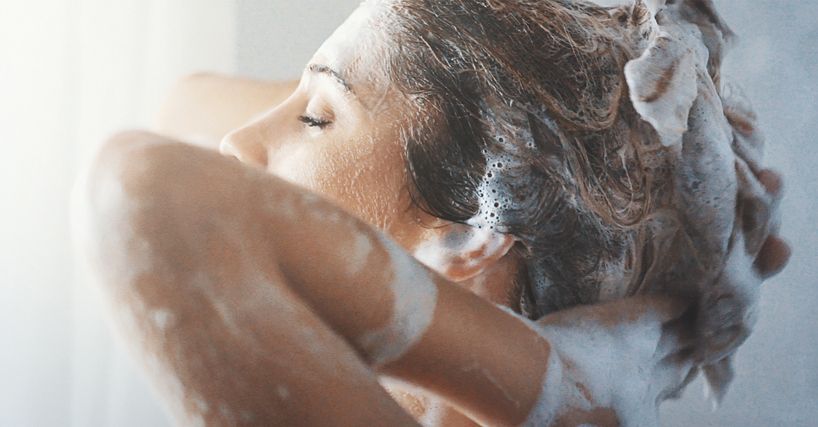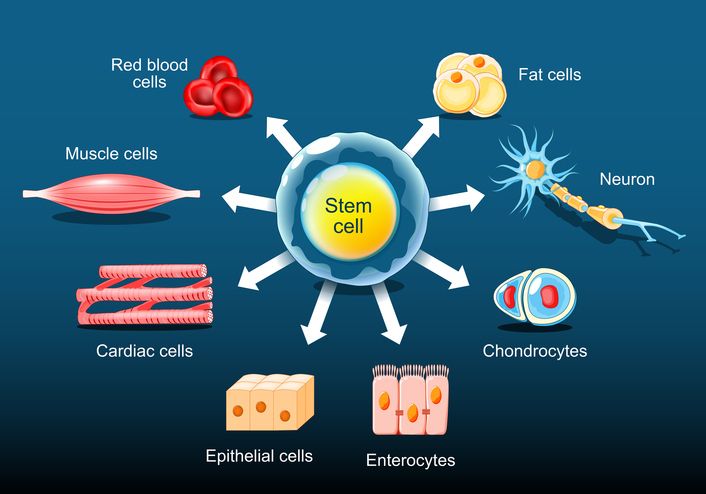
Author: Natalie Ng|Updated: 15 May 2025
When your body is under chronic stress, your hair often tells the story before you do. You might start noticing more hair coming out when you brush, a widening center hair part, or thinner areas near the temples or crown. Some people see patchy hair loss, breakage near the hairline, or a gradual drop in hair density behind the ears. These changes don’t all happen the same way or at the same pace. Each pattern connects to how stress affects the hair’s natural growth cycle. It can interrupt the balance between the growth and resting phases, weaken hair follicles, or push more hair into shedding too soon. Stress related hair loss often overlaps with other causes like female pattern hair loss, telogen effluvium, or alopecia areata. Things like tight hairstyles, hormonal imbalances, and even rapid weight loss can make things worse. Knowing the signs of each female stress hair loss pattern can help you respond early and protect your hair health. In the next sections, we’ll go through each pattern clearly so you can better understand what’s happening and what might help your hair grow stronger again. Keep reading to learn what each pattern looks like and how they relate to female pattern baldness, thinning hair, and the path back to healthy hair.

Diffuse Hair Thinning Across the Entire Scalp
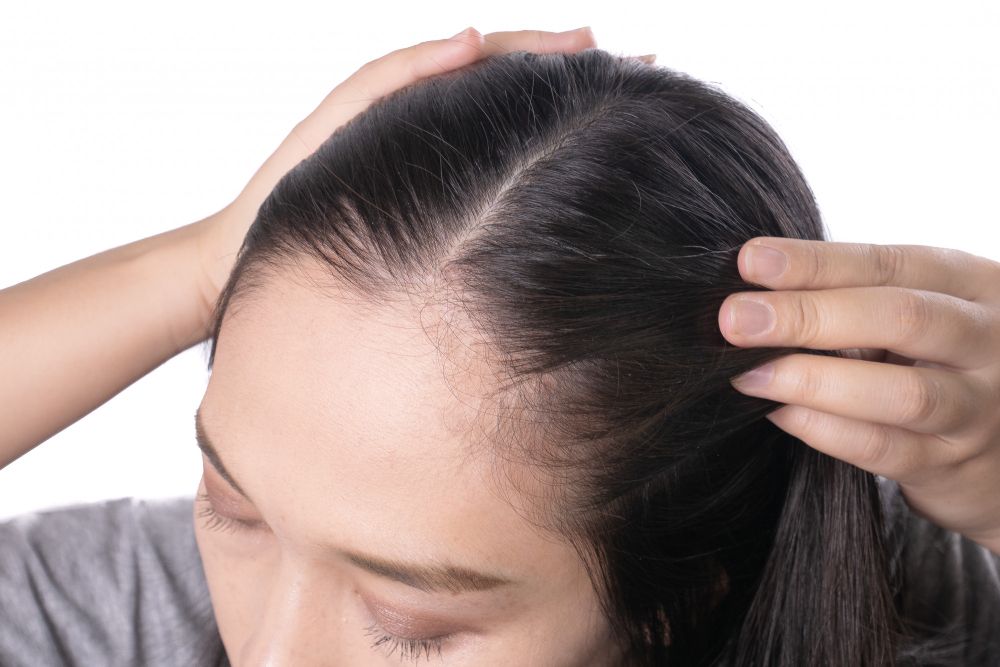
Early signs of female pattern hair loss from chronic stress
Stress hair loss in women often starts with a slow, even reduction in hair across the entire scalp. This thinning affects overall hair density without forming bald spots. You might first notice that your scalp is more visible, especially under bright lights or when your hair is wet. Your center hair part may look wider, and your ponytail may feel thinner.
Impact of chronic stress on the hair growth cycle
Diffuse thinning is commonly linked to telogen effluvium. Chronic stress pushes more hair follicles into the resting phase, leading to increased shedding across the scalp. This shift disrupts the natural hair growth cycle and reduces the number of strands in the active growth phase. Though the hair follicles are still alive, they pause new hair growth, which makes hair look less full.
Triggers linked to this pattern
Several factors can contribute, especially when combined with stress. These include rapid weight loss, illness, emotional stress, nutritional deficiencies, and hormonal imbalances. Certain medications, including birth control pills, may also disrupt the hair growth cycle. These triggers don’t destroy hair follicles, but they slow or stop new hair from growing.
Importance of early support for hair regrowth
While diffuse thinning can be alarming, it often responds well when the cause is addressed. Supporting healthy hair growth involves improving blood flow to the scalp, eating a balanced diet rich in essential nutrients, and reducing habits that damage hair shafts, such as excessive heat styling or chemical treatments. With time, lost hair can regrow if the follicles stay active and the growth phase resumes.

Widening of the Center Hair Part in Female Pattern Hair Loss
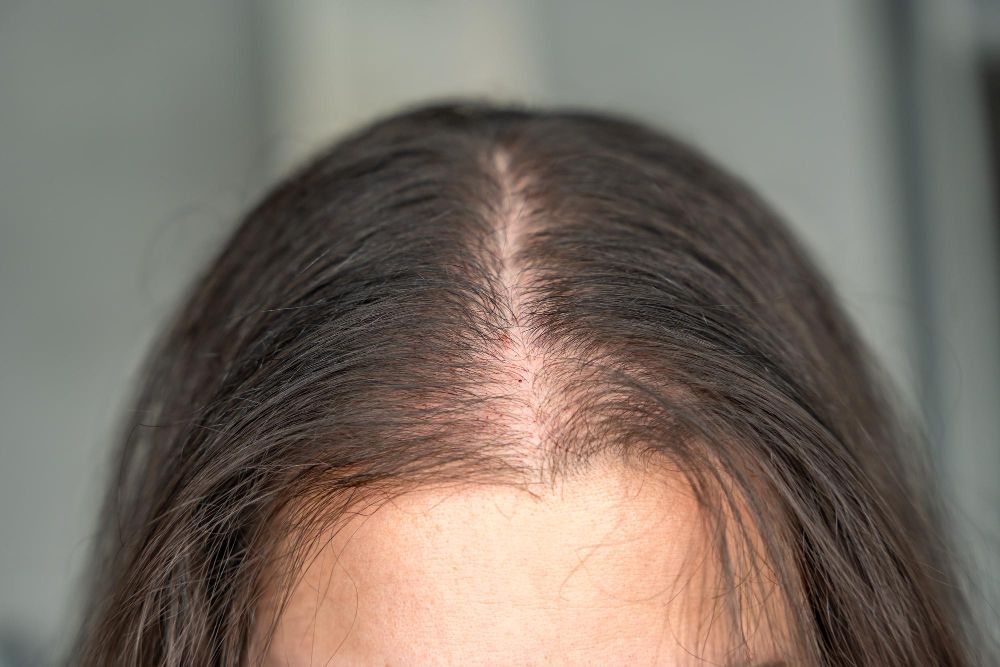
Early thinning signs in the central scalp
One common early sign of female pattern hair loss is a wider part along the center of your scalp. This often begins slowly, so it’s easy to overlook at first. You might notice your scalp showing through your center part more than usual, especially under light or in photos. Over time, this widening becomes harder to hide with your usual styling.
This pattern is more common in women than men and often signals the early stage of androgenetic alopecia. It starts with a gradual drop in hair density across the top of the scalp without affecting the frontal hairline right away.
Changes beneath the surface
Hair thinning in this area is usually caused by a shorter growth phase and more hair follicles entering the resting phase. Chronic stress, hormonal imbalances, and a family history of hair loss can all contribute. When these factors disrupt the hair growth cycle, hair becomes finer and grows slower. In some cases, miniaturized follicles stop producing new hair altogether.
The center part may look more defined, while the surrounding hair looks less full. Unlike patchy hair loss, this pattern creates a subtle yet steady loss of volume.
Importance of monitoring the center hair part
This pattern often progresses slowly, so visual tracking is important. Take regular photos of the parting from above and compare them over time. If your part continues to widen or the hair on either side starts to look sparse, that may be a sign of progressive female pattern baldness.
Central part widening can be worsened by excessive heat styling, tight hairstyles, or chemical treatments that weaken the hair shafts. It’s also affected by hormonal shifts, including those caused by birth control pills, rapid weight loss, or medical conditions such as PCOS.
Supporting new hair growth
Treatments that help stimulate hair growth in this area include topical minoxidil and oral medications such as spironolactone or finasteride, depending on your health history. Early use of these treatments helps support active follicles and may improve hair density over time.
Laser devices and platelet-rich plasma (PRP) therapy may also help improve blood circulation to the scalp, encouraging stronger regrowth. A balanced diet rich in key nutrients and avoiding unnecessary scalp stress can support long-term recovery.
Read More
Book Now to Experience
F8 Hair Regrowth Treatment
1 Minute Self-Registration
Date should not be before minimal date

Receding Hairline and Thinning at the Temples
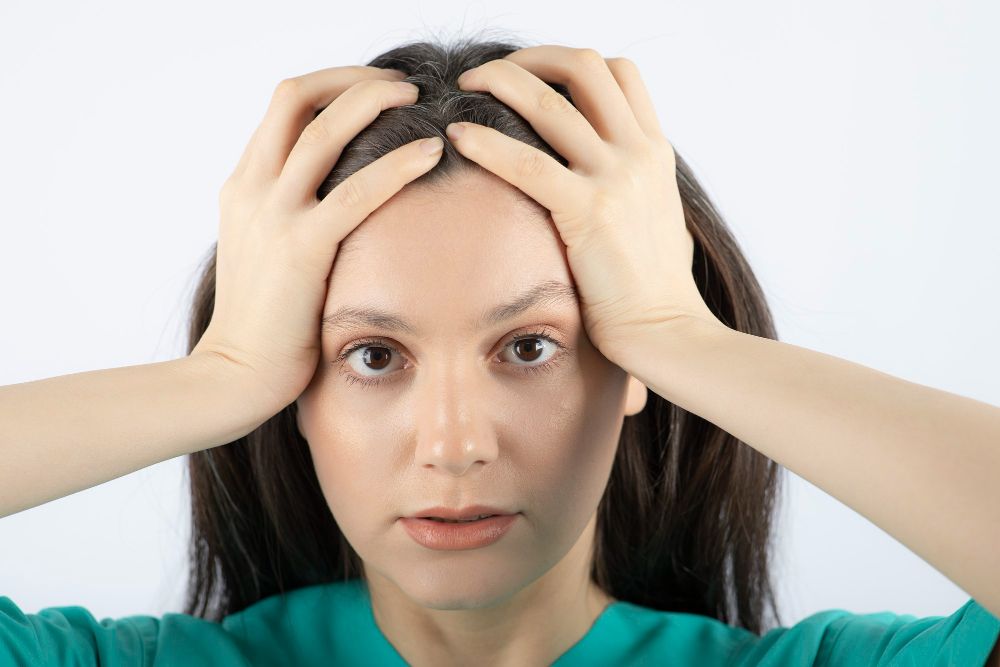
Gradual shift in hairline position and temple density
Hairline recession and thinning around the temples is another clear pattern of hair loss in women triggered by chronic stress or hormonal changes. This type of female hair loss typically appears slowly, starting with a soft pullback at the temples. Over time, the front edges of your hairline may look less defined, while the center hairline remains intact. This creates a subtle M-shaped pattern, which is often more noticeable when your hair is pulled back.
Unlike male pattern baldness, this pattern in women usually keeps the front line in place but reduces the density around it. It becomes easier to spot when you’re styling your hair or examining your face shape in the mirror.
Importance of hormone shifts and genetic factors
This hair loss pattern is often connected to changes in estrogen and androgens, particularly during perimenopause and menopause. A drop in estrogen and a rise in androgen levels can shorten the growth phase of the hair growth cycle and shrink follicles near the temples. Androgenic alopecia is one possible cause if there’s also a family history of female or male pattern baldness.
In many cases, stress adds to the impact by pushing more hairs into the resting phase, leading to thinner hair around the temples and frontal areas. While tight hairstyles don’t usually cause this recession directly, they can make the thinning worse by weakening already fragile hair shafts.
Slowing further hair loss and supporting recovery
Early signs of temple and hairline recession should be documented with photos, especially during periods of hormonal fluctuation. Treatments used to promote hair growth in this area include minoxidil, which helps extend the growth phase, and oral medications that reduce androgen impact. These may include spironolactone or finasteride.
Avoiding excessive heat styling and tension around the frontal hairline is also important to prevent further hair breakage. A balanced diet rich in nutrients that support healthy hair and improved blood flow to the scalp can support regrowth efforts. In some cases, medical treatments such as PRP may help reactivate weakened follicles and restore hair density in thinning areas.

Thinning at the Crown and Vertex of the Scalp
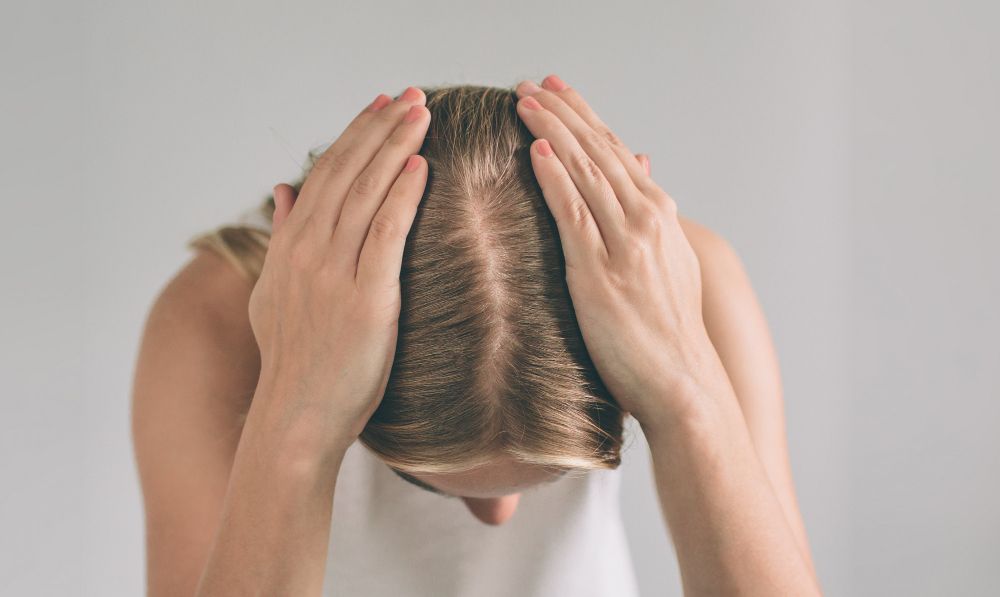
Drop in volume at the top of the head
Hair thinning at the crown and vertex often develops slowly, with hair becoming noticeably finer and less dense at the top of the scalp. This pattern tends to maintain the frontal hairline while reducing volume behind it. Over time, your scalp may begin to show through more clearly, especially under bright lighting or when your hair is wet.
One key visual sign is the development of a “Christmas tree” shape, where the part line widens as it moves back across the crown. This type of hair loss in women can be difficult to detect early, but the change becomes more visible as the thinning spreads outward.
Causes linked to female pattern baldness and chronic stress
Crown and vertex thinning is closely linked to female pattern baldness, also known as androgenetic alopecia. This condition is often influenced by genetic predisposition, hormonal imbalances, and disruptions in the hair growth cycle. Chronic stress compounds the problem by pushing more follicles into the resting phase, reducing active growth across the crown.
In some cases, thinning at the crown may be mistaken for normal aging, but when paired with increased shedding and slower new hair growth, it may point to a long-term condition. Androgenic activity often affects the crown area first in genetically predisposed women, especially during hormonal transitions such as menopause.
Supporting healthy hair growth at the crown
To help stimulate hair growth at the crown, early treatment is recommended. Topical minoxidil is commonly used to extend the growth phase and improve hair density in this area. Oral medications may also be considered if androgenic activity is suspected.
In addition to medical treatments, daily habits can play a role. Avoiding tight hairstyles that strain the crown and limiting the use of chemical treatments or excessive heat can reduce further damage. Nutritional deficiencies should also be addressed through a balanced diet rich in essential vitamins to support hair follicles.
Laser therapy and PRP treatments may help improve blood circulation and reactivate dormant follicles. Progress should be tracked with overhead photos to monitor hair regrowth and changes in density over time.
Book Now to Experience
F8 Hair Regrowth Treatment
1 Minute Self-Registration
Date should not be before minimal date

Patchy Hair Loss in Multiple Areas of the Scalp
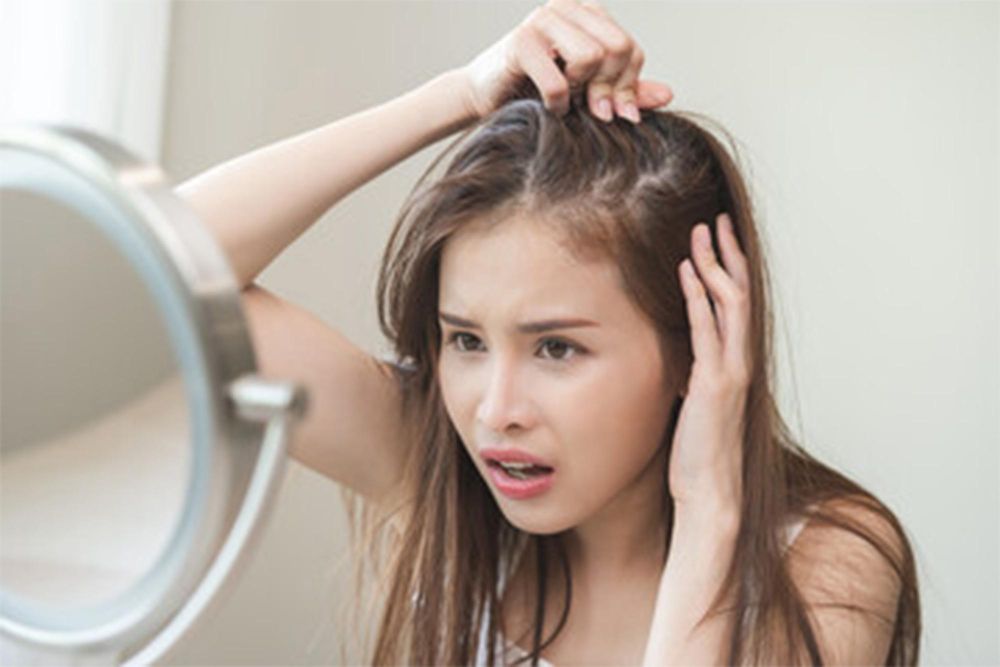
Irregular bald spots caused by stress or underlying conditions
Patchy hair loss is different from other types of female pattern hair loss. Instead of overall thinning, you may notice defined bald spots in various areas of the scalp. These spots often appear suddenly and can vary in size and shape. In some cases, they’re small and round. In others, they may be larger or irregular, affecting both sides of the scalp unevenly.
This pattern is often linked to alopecia areata, a condition where the immune system attacks hair follicles. It can also be triggered by emotional stress, rapid weight loss, certain medical conditions, or nutritional deficiencies. These spots may develop over weeks or months and can expand or multiply if the cause isn’t treated.
Changes in the scalp and hair growth cycle
When hair falls out in patches, it usually means those follicles have entered the resting phase early or have been interrupted mid-cycle. Blood flow to these areas may be reduced, and hair growth slows or stops completely. Inflammatory responses in the skin can also damage hair follicles temporarily, which delays regrowth.
You may notice that the affected areas feel smooth and lack visible hair shafts. Some spots may show mild redness or slight irritation, especially if the hair is pulled or brushed. Patchy loss from stress or medical issues often begins with subtle thinning before leading to visible hair shedding.
Tracking changes in patch location, size, and shape
Since patchy hair loss doesn’t always follow a predictable pattern, it helps to track each affected area closely. Use photos and measurements to monitor progression. Check for new patches developing on the sides, back, or top of the scalp. Keep note of texture changes, redness, or sensitivity, which may signal inflammation.
Patchy hair loss caused by severe stress can also overlap with telogen effluvium, especially if it’s widespread. This makes tracking duration and shape even more important for identifying the root cause and responding early.
Supporting regrowth and treating the cause
Treating female patchy hair loss often requires a full health review. Blood tests may be needed to rule out hormonal imbalances, vitamin deficiencies, or autoimmune issues. In cases related to alopecia areata or stress hair loss, treatments may include corticosteroid injections, topical medications, or PRP therapy to stimulate hair growth.
In milder cases, improving blood circulation through scalp massage, following a balanced diet, and avoiding chemical treatments or tight hairstyles can help promote hair regrowth. Identifying and reducing emotional stress also supports the hair’s natural growth cycle and prevents further hair loss.

Hair Breakage Along the Hairline from Styling Stress

Fragile strands at the forehead and temples
Hair breakage along the hairline often develops from repeated tension, heat, or harsh products. Unlike hair loss caused by shedding or follicle damage, breakage happens when the hair shafts weaken and snap. This leaves short, uneven strands around the forehead, temples, and sideburns. You might notice a fine halo of broken hairs that don’t grow past a certain length or seem thinner than the rest of your hair.
This type of thinning is common in women who frequently use tight hairstyles, such as ponytails, buns, or braids. It also affects those who rely heavily on heat styling tools or chemical treatments. Over time, these habits weaken the hair shaft and reduce its ability to grow without damage.
Impact of daily styling routines on hair health
Constant pulling, excessive brushing, and heat styling can break down the outer layer of the hair. This makes strands more likely to snap, especially near the hairline where hair is finer and more exposed. When combined with stress or hormonal shifts, breakage becomes more noticeable and harder to repair.
This pattern often affects the front and side edges of the scalp first. You may also feel mild irritation or tenderness where tension is highest. In some cases, repeated breakage can lead to traction alopecia if the stress continues over long periods.
Steps to protect the hairline and support healthy regrowth
Resting the hairline from tension is essential. Wearing looser styles, switching up parts, and avoiding frequent use of heat tools can help reduce further breakage. Avoiding chemical relaxers or bleach around the front hairline also helps prevent long-term damage to fragile strands.
Hair growth in these areas depends on keeping the follicles healthy. Scalp-friendly habits, including gentle cleansing and moisturizing, can help maintain the environment needed for new hair growth. Supporting the hair internally with a balanced diet and key nutrients is also important for stronger strands.
In some cases, topical products or growth-supporting treatments may be used to stimulate hair regrowth. Minoxidil may help reactivate follicles in areas where breakage has led to thinning. If breakage continues or worsens, a medical review may be needed to check for hormonal imbalances or nutritional deficiencies affecting the strength of hair shafts.
Book Now to Experience
F8 Hair Regrowth Treatment
1 Minute Self-Registration
Date should not be before minimal date

Loss of Hair Density Behind the Ears
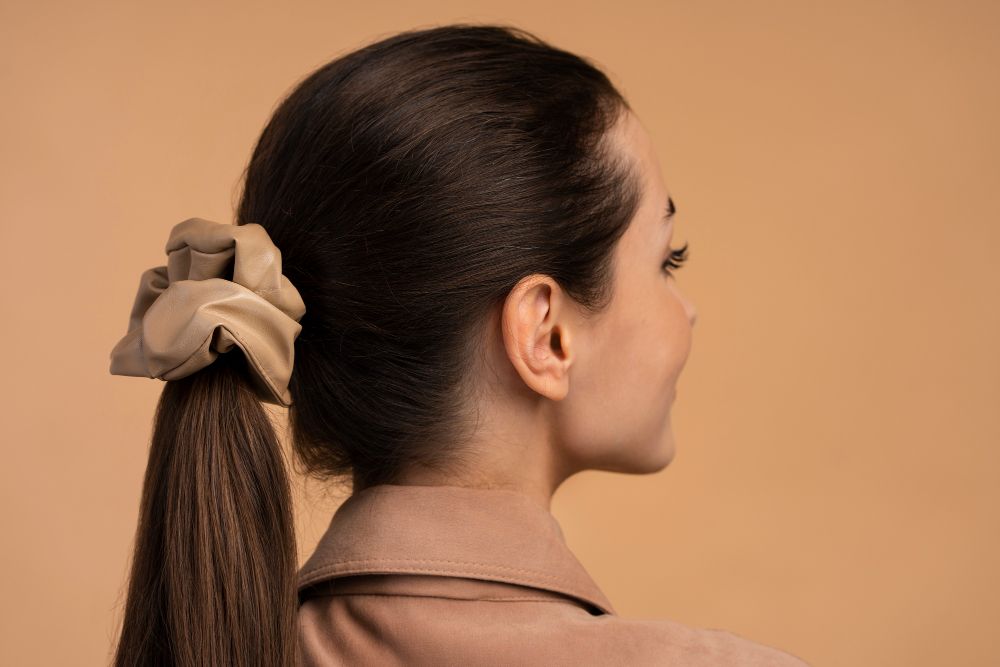
Subtle thinning in an overlooked area
Hair thinning behind the ears is easy to miss until it becomes more advanced. This area is often covered by surrounding hair, so the loss can go unnoticed until styling reveals reduced volume or uneven patches. You might feel that the hair behind your ears is lighter, less dense, or more fragile when running your fingers through it. Some women discover it when pulling their hair back or tying it up, especially if scalp visibility increases near the nape.
This pattern can occur alone or along with other types of female hair loss. It may reflect tension from styling habits, chronic stress, or changes in the hair’s natural growth cycle. In some cases, it also overlaps with early signs of telogen effluvium or traction-related loss.
Causes linked to physical strain and scalp sensitivity
Thinning behind the ears is often linked to mechanical strain from tight hairstyles that pull hair backward and anchor near the sides. Over time, this weakens the hair shafts and leads to gradual breakage or shedding. Chronic stress may worsen this by interrupting the growth phase and slowing new hair growth in affected areas.
Heat exposure from curling irons or blow dryers can also affect this region if used repeatedly near the ears. Chemical treatments, such as relaxers or hair dyes applied close to the scalp, may contribute to reduced hair density by weakening nearby follicles.
Promoting hair growth and protecting the area
To support regrowth, reduce tension in hairstyles and avoid pulling hair tight around the ears. Letting hair rest in natural positions or wearing loose styles helps prevent further mechanical stress. It’s also helpful to avoid applying heat or harsh products near this area.
If the thinning is linked to stress or nutritional deficiencies, focus on restoring balance through a healthy lifestyle. A balanced diet rich in hair-supporting nutrients and adequate sleep can improve blood flow to the scalp and help stimulate hair growth. Scalp massages and gentle hair care products can support this area’s recovery over time.
For more advanced cases, treatments such as minoxidil or PRP therapy may be used to encourage new hair growth. If hair density continues to drop or doesn’t improve, medical evaluation may be needed to rule out underlying conditions affecting the growth cycle or hormone levels.

Supporting Hair Regrowth with F8 Hair Regrowth Treatment
Targeting female stress hair loss patterns at the root
For women experiencing stress related hair loss, especially patterns like diffuse thinning, center part widening, or thinning at the crown, a consistent treatment approach can help reactivate hair follicles and improve overall scalp health. The F8 Hair Regrowth Treatment offers a non-invasive solution that supports the natural hair growth cycle by combining low-energy laser therapy with a hair growth serum that deeply nourishes the scalp.
This treatment is suitable for various types of female hair loss, including androgenetic alopecia, telogen effluvium, and thinning caused by hormonal changes or chronic stress. It’s designed for both women and men experiencing hair density loss, and is especially helpful for those seeing gradual reduction in volume or slow new hair growth.
How F8 Hair Regrowth Treatment works
The F8 treatment begins with a scalp analysis to identify the cause and severity of hair loss. Then, low-level laser energy is applied evenly across the scalp to stimulate inactive follicles and encourage blood flow through the surrounding capillaries. This helps increase the delivery of nutrients to the hair papilla and supports healthier hair follicles.
Following the laser step, a hair growth serum is applied to hydrate the scalp, cleanse blocked follicles, and rebalance oil production. The serum absorbs easily after laser exposure, creating a cleaner environment that helps promote hair growth.
Benefits of the F8 Hair Regrowth Treatment
• Non-invasive and gentle: No downtime or discomfort. The treatment does not involve surgery or cause damage to the scalp.
• Improves scalp conditions: Helps cleanse sebum buildup, unclog follicles, and regulate oil levels that affect thinning hair.
• Boosts blood circulation: The laser energy enhances capillary strength and improves nutrient delivery to support new hair growth.
• Supports various hair loss patterns: Suitable for women with diffuse thinning, patchy hair loss, or female pattern baldness linked to hormonal imbalance or stress.
• Safe for repeated use: Recommended over a period of 3 to 6 months, with no disruption to daily life.
A non-invasive way to promote hair growth
F8 Hair Regrowth Treatment is a suitable option for women looking to treat female pattern baldness or stress-related thinning without medication or invasive procedures. It helps restore hair health by supporting the scalp environment and reactivating the hair growth cycle.
If you’ve started to notice hair thinning, patchy loss, or a widening center part, this treatment may help improve density and support long-term scalp recovery.
Book F8 today and take the first step toward stronger, healthier hair.
New Beauty's F8 Hair Regrowth TreatmentBook Now to Experience
F8 Hair Regrowth Treatment
1 Minute Self-Registration
Date should not be before minimal date
FAQ
1. Can female pattern hair loss skip generations?
Yes, female pattern hair loss can skip generations. While a family history of female or male pattern baldness increases your risk, the condition is influenced by multiple genes and hormonal factors. This means you can develop androgenetic alopecia even if your immediate family members don’t show visible signs of hair loss. Genetic predisposition, combined with triggers like chronic stress or hormonal imbalances, often determines when and how hair thinning begins.
2. Is hair thinning the same as hair shedding?
No, hair thinning and hair shedding are not the same. Hair shedding, especially in conditions like telogen effluvium, involves more strands falling out at once but often grows back after the trigger is resolved. Hair thinning is a gradual process where hair becomes finer, and hair follicles shrink over time, often linked to female pattern hair loss or stress related hair loss. Thinning may not reverse as easily and often requires treatments that stimulate hair growth and improve follicle health.
3. Can tight hairstyles cause permanent hair loss?
Yes, prolonged use of tight hairstyles can lead to a condition called traction alopecia. This occurs when repeated tension damages the hair follicles, especially around the temples and hairline. Over time, this may cause permanent hair loss if the follicles become scarred. Reducing tension, switching to looser styles, and supporting healthy hair with scalp treatments can help prevent further hair loss and promote hair growth.
4. How long does it take to see new hair growth after treatment?
New hair growth timelines vary depending on the cause of hair loss and the type of treatment used. In most cases, you may begin to see early signs of regrowth within 3 to 4 months. Treatments like minoxidil, PRP, or laser therapy can support the hair growth cycle, but results often appear gradually. Consistency and patience are key, as hair needs time to move through each phase of the growth cycle before visible results become noticeable.
5. Can emotional stress alone cause hair loss in women?
Yes, emotional stress can lead to hair loss in women. Stress disrupts the normal growth phase of hair and may push more follicles into the resting phase, triggering telogen effluvium. This can result in noticeable hair shedding across the entire scalp. In severe or prolonged cases, emotional stress can also worsen conditions like female pattern baldness or alopecia areata. Managing stress, improving overall health, and starting targeted scalp treatments can help support recovery and improve long-term hair health.
Recommended Articles
COPYRIGHT© NEW BEAUTY MANAGEMENT LIMITED 2025. ALL RIGHT RESERVED.

